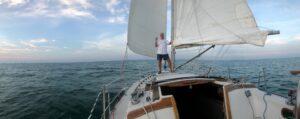True North and Magnetic North
In the world of navigation, two terms often get tossed around: true north and magnetic north. While they sound similar, they’re not exactly the same. Understanding the difference between them is crucial for accurate navigation, especially when relying on a compass.
True North
True north refers to the fixed point on Earth’s axis around which the planet spins. It’s like a giant bullseye at the top of the globe. Magnetic north, on the other hand, is the direction the compass needle points. It’s not fixed and can vary depending on your location on Earth. This difference between true north and magnetic north is called variation.
Maps and directions are usually oriented toward the Geographic Pole, also referred to as “True North
Variation
Variation is caused by the Earth’s magnetic field, which isn’t uniform. Imagine Earth as a giant bar magnet with its poles not exactly at the geographic north and south poles. This means the compass needle gets pulled slightly off true north by the magnetic field. The amount of variation depends on where you are on the planet.
Deviation
Now, let’s talk about deviation. Deviation is a local effect caused by magnetic fields on the boat itself. Things like the engine, electrical wiring, and even cargo can create their own magnetic fields, further influencing the compass needle. Deviation needs to be factored in when steering to ensure you’re actually going in the direction you intend.
So, how do you keep these two straight and navigate accurately? Here are some tips:
- Get a chart: A nautical chart will show you the variation for your specific area. This will be your baseline for adjusting for true north.
- Use a compass with deviation adjustment: Many compasses have a built-in mechanism to adjust for deviation. This involves lining up a mark on the compass with a mark on the boat to compensate for the local magnetic fields.
- Remember the saying: “West is best, east is least,” is a handy way to remember how to add or subtract variation. If the variation is west of true north, add it to your compass reading. If it’s east, subtract it.
Unlike the ‘Geographic’ North Pole, the ‘Magnetic’ North Pole, is aligned with Earth’s magnetic field. According to the International Geomagnetic Reference Field model, the North Magnetic Pole is currently located just beyond the Canadian Arctic at 86.50°N latitude 164.4°E longitude.. This is just beyond the Canadian

.By understanding the difference between variation and deviation and knowing how to account for them, you can navigate with confidence. Remember, a little knowledge can go a long way in ensuring a smooth and safe journey!




